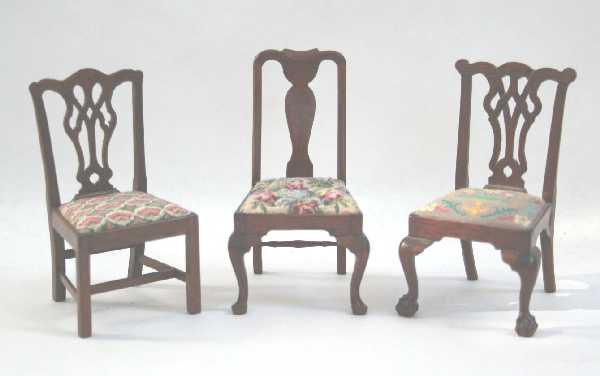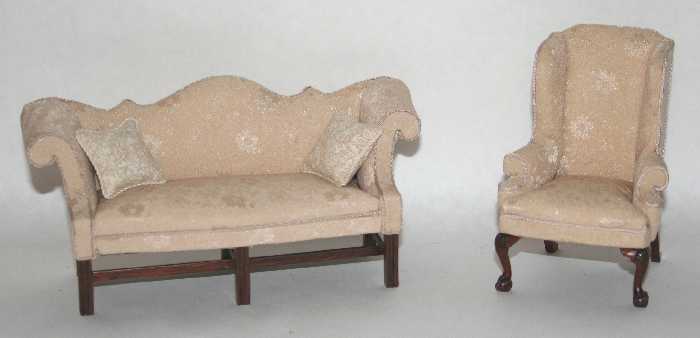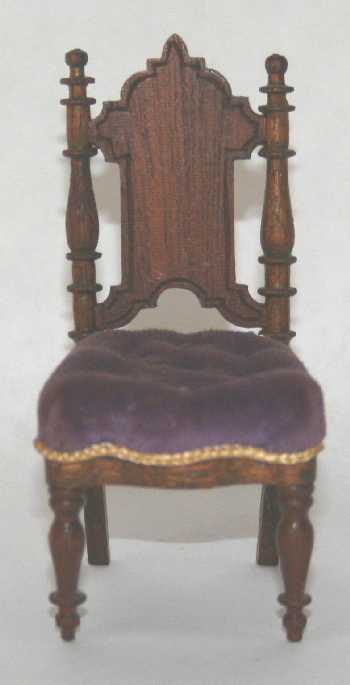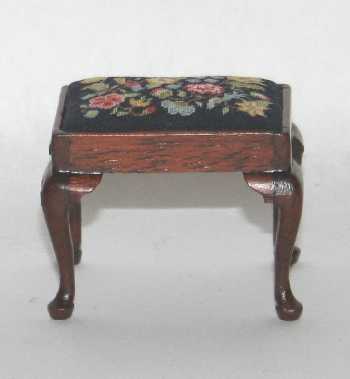Warren Dick
Molly Brody sold Warren Dick furniture in her shop in Westport and I used to marvel at the precision of his turnings and clean assembly. I liked his darker pieces which had more of a finish on them, while many of the maple-colored pieces seemed almost unfinished to me and very new looking. I have accumulated several tables and smaller items of his over the years, but these particular pieces are favorites.
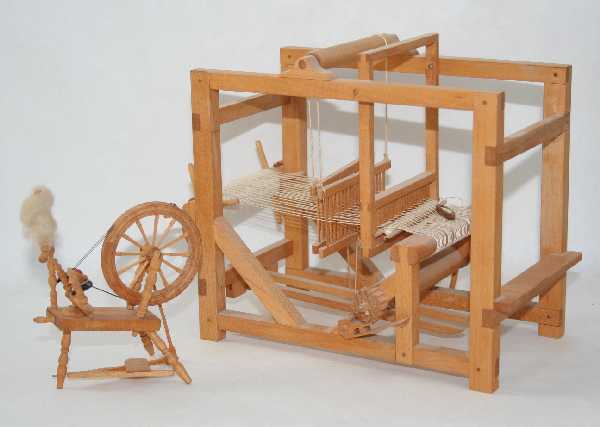
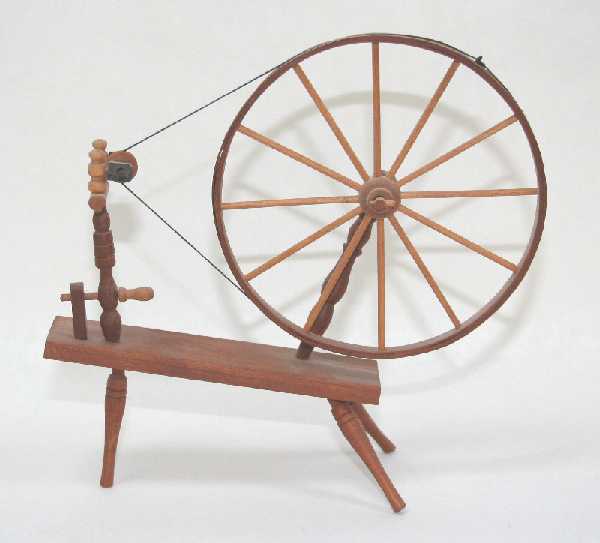
Fred Early
For years, my only exposure to the work of English craftsman Fred Early (sometimes referred to as Frank Early in some texts) was through books with photographs of museum collections and then about ten years ago I finally got to see Queen Mary's dolls' house at Windsor Castle...sigh. With several feet of space and walls of glass between viewers and the dolls' house, I never imagined I'd have an opportunity to actually handle one of his pieces. The summer of 2005 I began working with Noel Barrett and Andy Ourant preparing to auction the collection of Carolyn Sunstein. Many of Carolyn's finest artisan pieces were displayed in roomboxes custom-built by Robert Bernhardt, who used to trade under the name of Dolphin Originals. Bob built her a handsome library to house some vintage craftsman pieces, including works by Fred Early and Eric Pearson. The roombox had already been photographed for the catalogue with its contents intact, but when I saw the valuable pieces it contained, I persuaded Andy to forfeit the previous photography and sell the contents separately. When we removed the furnishings from the roombox, I was able to fully appreciate the incredible craftsmanship and unbelievable patina of the Early secretary that was the highlight of the room's contents.
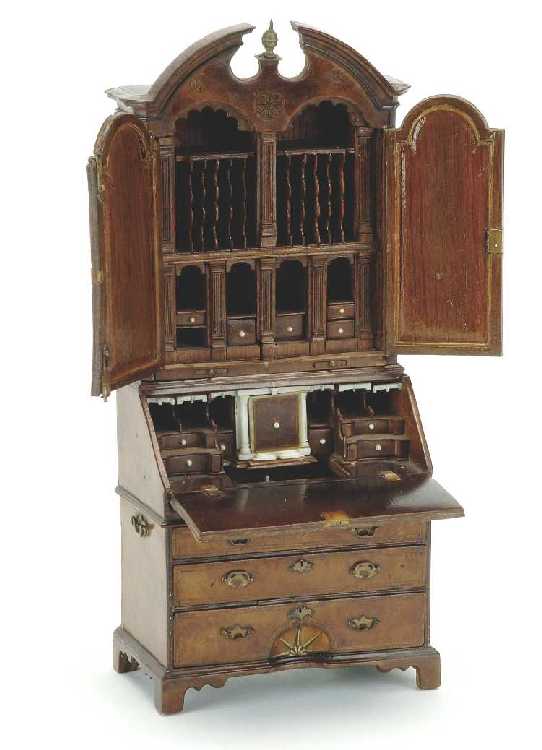
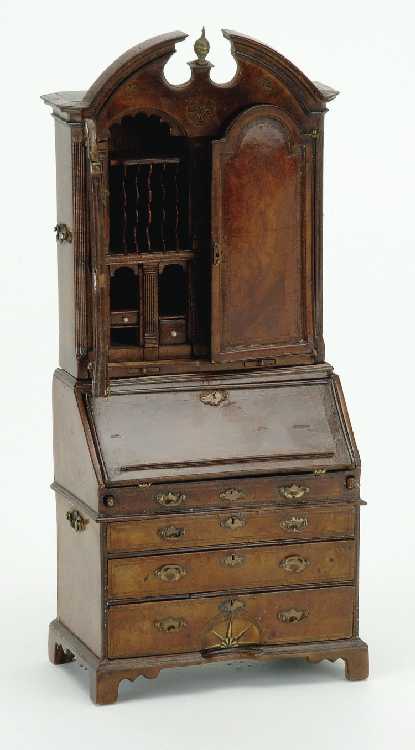
Ted Norton
Norton's work was completely beyond my means when I first saw it in person at the Darien show in 1976. He occupied a position within the artisan community much the way someone like John Hodgson or Geoffrey Wonnacut does now, and I felt somehow unqualified to even stand in front of his booth in those days - I was in awe. I was delighted to win an early Victorian secretary at Eileen Rhoads' auction of the contents of Maynard Manor back in 2003, and I have searched it out on the secondary market since then. This handsome Winthrop desk with serpentine front was purchased from Gloria Hinkel last year, and I found her original invoice for it in one of the drawers after I got it home. It was a good buy. The ball and claw feet and intricately fashioned interior compartments are very pleasing to me.
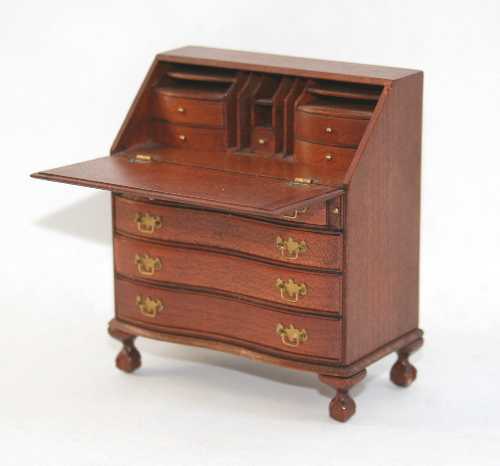
Eric Pearson
My first exposure to the work of the legendary Eric Pearson occurred one afternoon in the Spring of 1977. My employer at that time was Molly Brody, one of the pioneers in dollhouse retailing. Molly and her husband, Sol Brody, were graduates of Cooper Union and Molly was an established decorator and antiques dealer before immersing herself in the world of miniatures. She always brought her highly trained artistic eye to her endeavors and even created her own line of dollhouse wallpapers which were availably exclusively in her shop (originally named The Golden Bough but later changed to Molly Brody Miniatures ) and by mail order. I particularly remember her small-scale French toiles.
One of Molly's favorite customers and a friend was Gretchen Deans, who with Caye MacLaren and Dee Snyder, founded the original (and never improved upon) Nutshell News , and in 1977, her collection was displayed throughout several rooms in her New Canaan, CT home. She had a great folky mouse house right in her kitchen, just steps from her kitchen sink, but another room was dominated by the huge four-story mansion shown in the now out-of-print book, This Side of Yesterday. The photograph in the book was a very high quality photo taken by a professional photographer, to be used on the cover of a rock and roll album. I forget the name of the group, whose figures were superimposed into the rooms.
The dollhouse was open on two sides and filled with nothing but fine craftsman furniture. It's difficult to convey the excitement I felt when I first saw this dollhouse and the unbelievably fine miniatures it contained, at a time when the nicest things in my own dollhouse were some treasured pieces of Lynnfield and a Betty Valentine tripod table. The most exquisite pieces had to be the furniture crafted by Eric Pearson. I was privileged to spend several hours at Molly's tutorial knee as she pointed out the most outstanding examples with impossibly fine satinwood inlays and hand-carved ball and claw feet. She explained to me how that incredibly smooth varnished finish was an unique hallmark of Pearson's work and it was a lesson I never forgot. The cost of his furniture, even in those days, was far beyond the ambitions of my meagre purse and by 1977, it was beginning to be difficult to acquire such pieces, so I waited many years until his work began to show up on the secondary market, in specialty auctions. One of my pieces was discovered on ebay, unattributed, but the finish was unmistakeable and I was shocked to win it for only $15!
I corresponded with Gretchen and she helped me clear up some of the attributions shown here in the past. Several of the pieces were acquired from the collection of Gloria Hinkel and when she purchased them, she was told they were Eric Pearson and assured me of the same, but the bed was actually an early Chestnut Hill creation, with the canopy and amazing bedspread made by Gretchen - I had no idea and I am just delighted to own a piece that was formerly in her collection, Pearson or not!
Until the recent slide in the economy, I found that when pieces are correctly attributed to him, they fetch prices as good or better than those paid for today's artisan pieces, but when they sit un-noticed in a box lot or indifferently catalogued at less conscientious auction houses, they can be acquired at bargain prices. Pictures do not convey the quality of the finish that sets Pearson apart from everyone else, so one must examine them in person to learn to recognize his work. He did not sign his pieces, but his chairs often have a black twill fabric, like ribbon, glued under the seats. Examples of his furniture can be seen at the Kansas City museum and in the Kruger Collection and the University of Nebraska - do let me know if you know of any other museums showcasing his work and I will update this page.
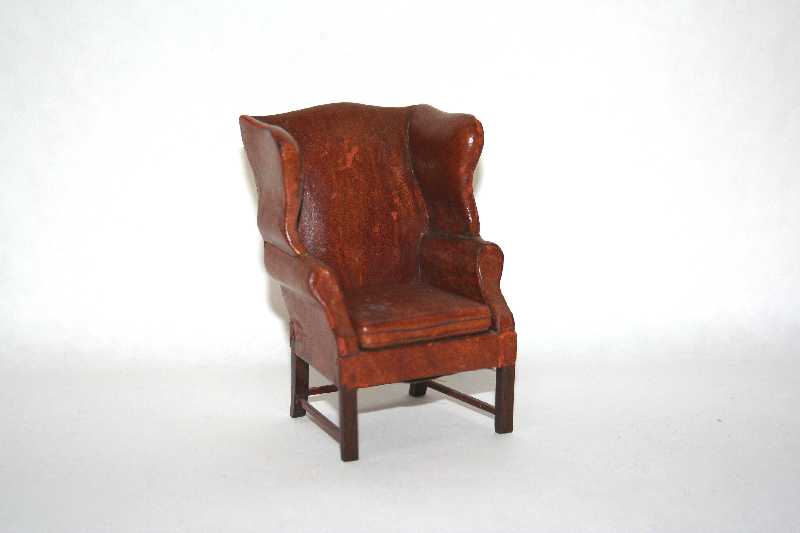
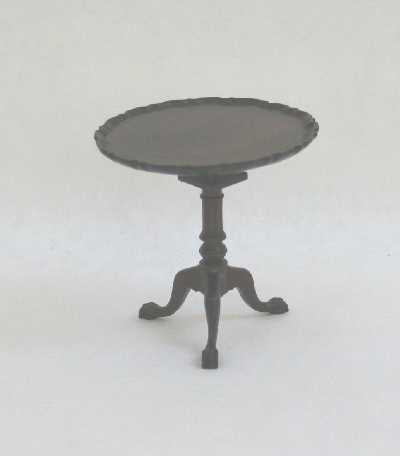
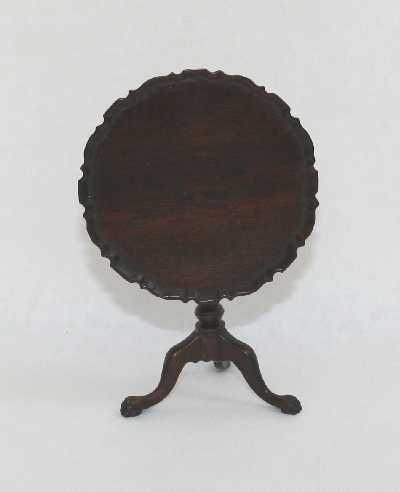
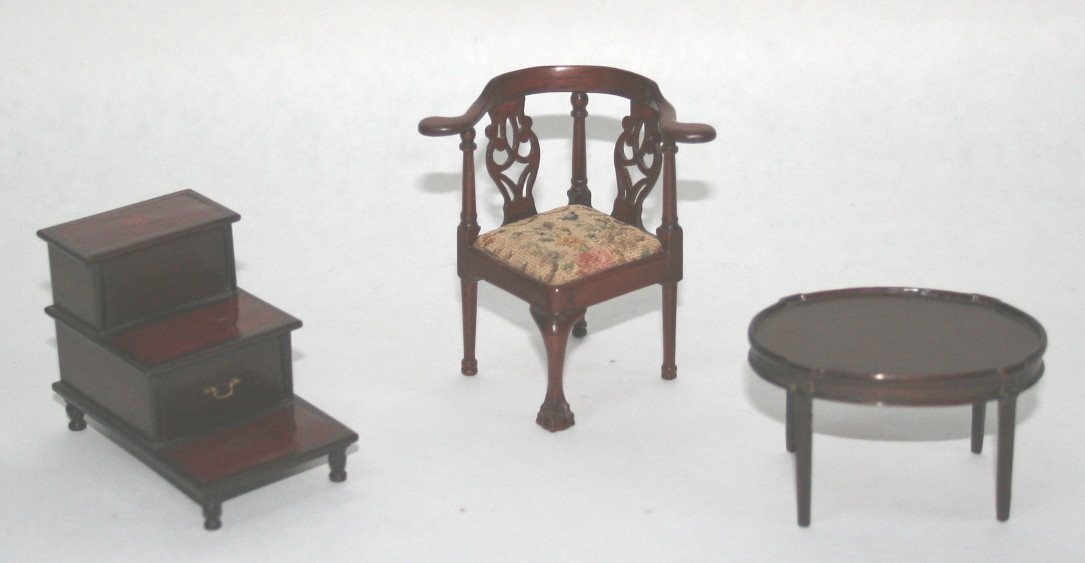
The library steps with leather inlays are from the collection of Carolyn Sunstein, the oval coffee table was a bargain on ebay for only $15, and the lovely corner chair was a surprise gift from my mother - she never told me how she got it, but I think Molly Brody might have had something to do with it!
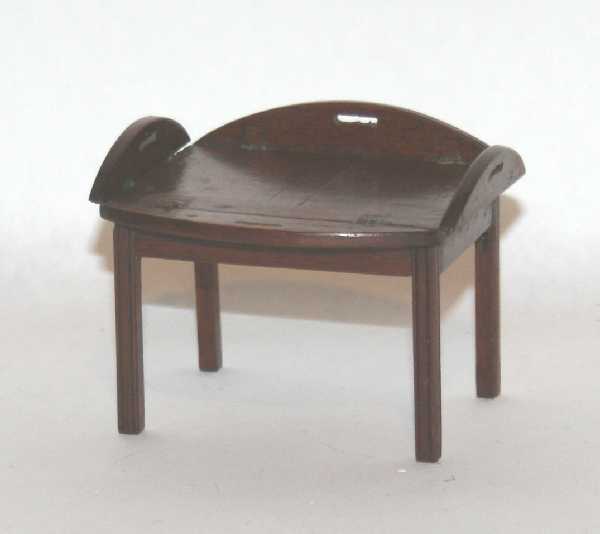
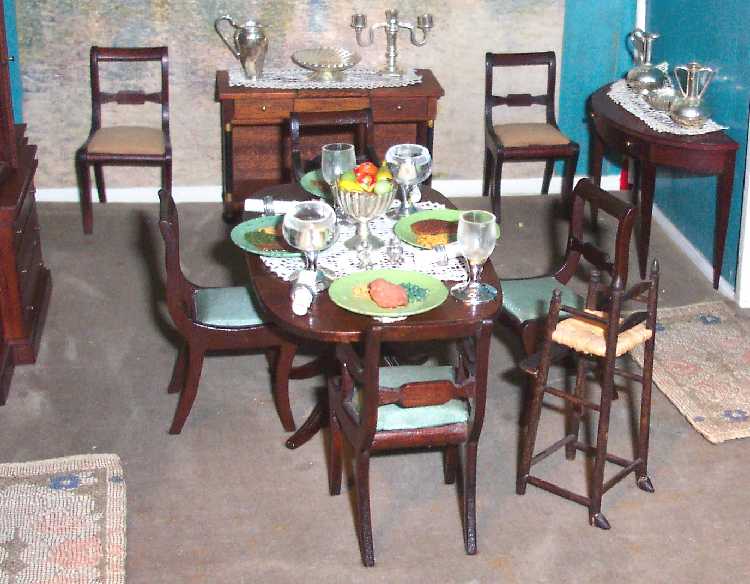
Betty Valentine
When I think of the perfectly scaled miniature chairs, I think of Betty Valentine. There is something about the very solid way her chairs "sit" that appeals to me. Although the very first pieces I bought from her at the Darien show were small occasional tables, it was her robust little chairs that I always coveted. The seats on the chairs below were made by Annelle Ferguson.
